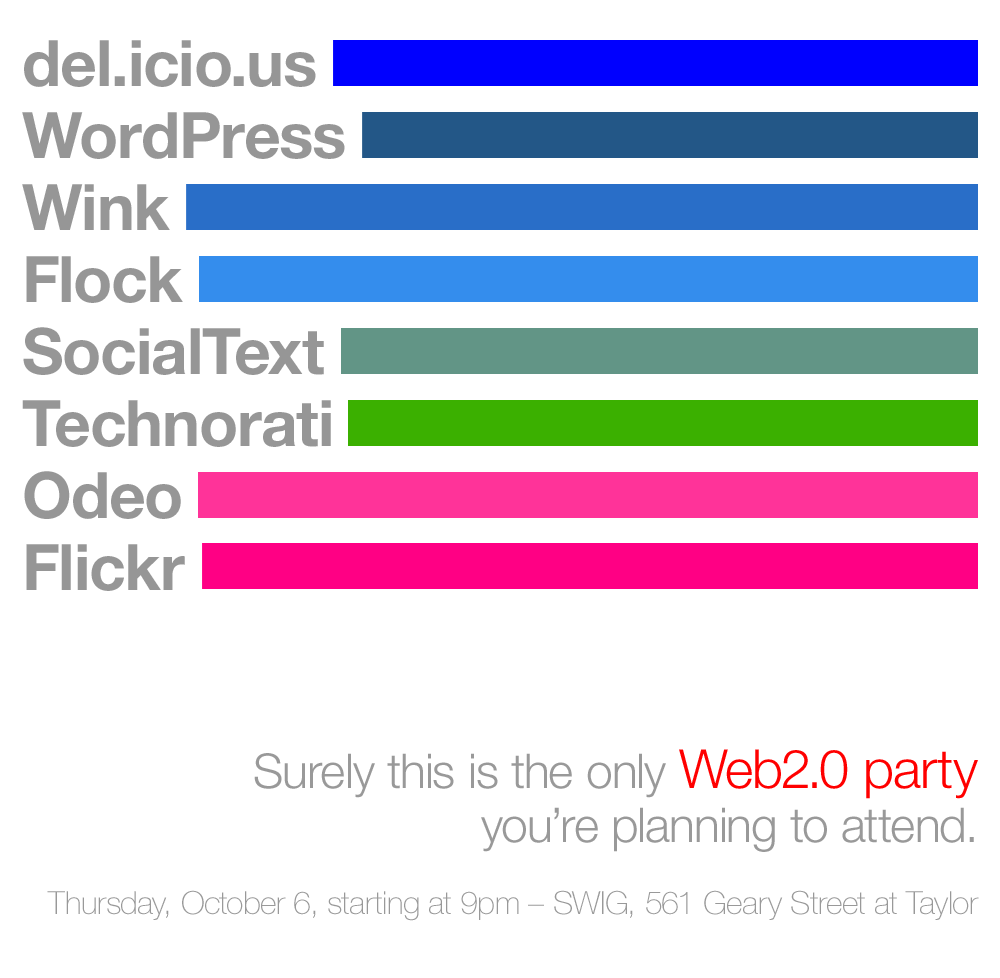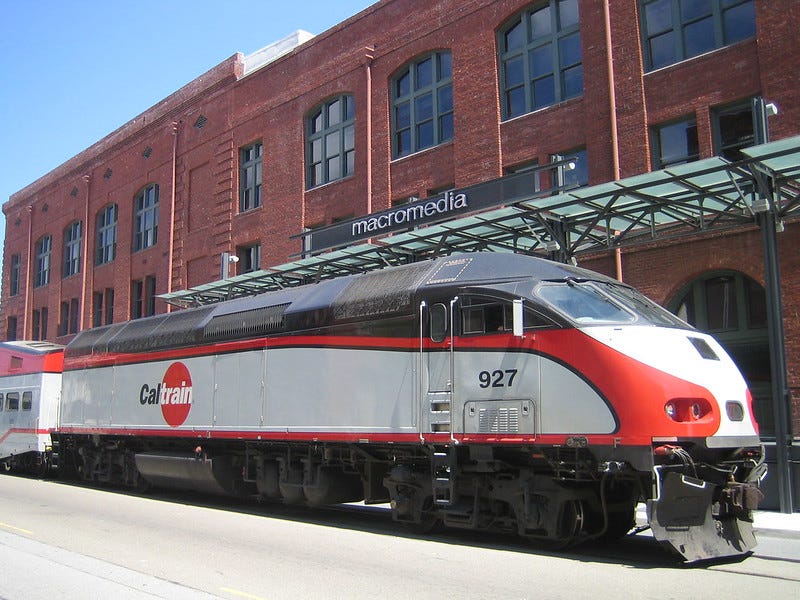The Colors of Web 2.0 Party; October 2005
I attend a hyped Web 2.0 party; later in the night, I desparately try to catch the last train back to Silicon Valley.

The Colors of Web 2.0 Party was held on Thursday, October 6, 2005, at Swig — a modern bar spread over two floors in Geary St, a few blocks up from Union Square. The event notice on Upcoming.org read, “While the big guys are giving away stress balls and business card holders, Flock, del.icio.us, Flickr, Odeo, Technorati, wink, and WordPress will be tending bar all night (read: free drinks!), tossing out t-shirts that were not made in sweatshops (seriously).”

The invite; photo by Chris Messina.
Swig was heaving with people when I arrived. Many of the young and hip partygoers were employees of the startups mentioned in the promo, or friends of theirs. If they’d been at the conference earlier today, it was only to hang out in the hallways. The people who attended the conference keynotes, like me, were the other half of the party. We were less cool and slightly older — a mix of investors, founders, PR folks, and bloggers or journalists.

Chris Messina, Nicole Lee, Niall Kennedy. Photo by Kris Krug.
I mostly stuck with my new Irish friends at the party and over the hubbub of an overcrowded bar, we talked about the Web 2.0 scene and our places in it. I told them that Read/Write Web and Techcrunch together probably had 70% of the conference attendees reading us — with me mostly focusing on Web 2.0 analysis and Mike covering the new startups.
I was also writing a blog for ZDNet, an established tech news brand owned by CNET. It was called Web 2.0 Explorer — “Tales from the Web 2.0 frontier” was the tagline I’d come up with — and in it I covered much the same material as on RWW, although I tried to give it more of an enterprise slant. Meaning I blogged about the “web office,” the business models of mashups, and the like. Fergus Burns pointed out that there was still too much overlap in audience, which siphoned away juice from my RWW brand. He suggested I write about Web 2.0 for mainstream news websites like BBC or the Guardian, or even the Silicon Valley magazine Business 2.0. It was a good suggestion, as mainstream media had yet to discover Web 2.0.

Photo by Tara Hunt.
I remember it was a fun evening and I’m sure I half-listened to some shouted startup pitches as I moved to and from the bar. But I don’t have any party hijinks to report. Later I saw some photos taken by Kris Krug, a Canadian photographer about my age who I would often bump into at web conferences over the coming years. He’d been brought down from Vancouver by the startup Flock to take some official photos. In his blog post, Kris said it was “definately the best party of the conference.” He added that there were some “unsanctioned” photos from a disposable camera he’d bought, taken at an after-party in someone’s hotel room.

The after-party I was either too cool to attend, or wasn’t cool enough to attend (I’ll leave it to the reader to decide). Photo by Kris Krug.
I hadn’t been invited to the after-party, and in any case I was focused on getting back to Silicon Valley that night. Since Mike and Keith weren’t at the Swig party, I had to make sure I got the last Caltrain back to Atherton — it left around midnight.
Sometime between 10 and 11pm, after we’d had enough of the crowds and noise at Swig, I said goodbye to my Irish friends. They were staying at a hotel near Geary St, within stumbling distance of the party. My blog buddy Josh Porter was staying near the conference venue, so he and I began walking down to Market St together. It would be a chance for us to chat about our meeting with Tim O’Reilly, so I was pleased to have company on my way to the train station.

My ZDNet blog, which I started at the end of August 2005.
As we ambled along, Josh and I discussed learnings from the event that we might want to put into the O’Reilly Media book that we’d been commissioned to write. I don’t recall specifically what we talked about, but perhaps it was “structured blogging,” one of the hot topics of the conference. That was all about publishing different kinds of information — like events, reviews and classified ads — using semantic markup, so that aggregators can pick up the data from all over the web. It was exciting in 2005 because it would be a way of extending blogging beyond navel-gazing, which was what it was primarily known for at the time (a little unfairly, given that some of us were becoming journalists).
Josh was telling me about a guy he’d met at the conference, who was building a tool to help people do things like movie reviews on blogs. “If they want to write a movie review,” he explained, “they simply fill out a form with helpful fields for movie reviews: rating it, a brief synopsis, principal actors, etc.” Josh was the more pragmatic of the two of us; he was a practicing web designer who focused on the usability of technology. For him, blogging was a tool that could potentially be utilized by ordinary people in order to help others. As we discussed movie reviews, he remarked, “Don’t you really appreciate it when someone tells you whether or not to waste your time going to a movie? They’ve added 2 hours to your life.”

The Structured Blogging website, circa December 2005.
We came out on Market St where it connected with Third St. Since Josh’s hotel was down towards Second and First, we continued in that direction — I still had some time to kill before my train.
We continued to talk about Web 2.0. I was more interested in the higher-order patterns of web design, so I was prone to highfalutin theories like “design for data” — applying web design principles to data. Talking about movie reviews with Josh, as we half-drunkenly wandered around San Francisco late on a Thursday night, I might’ve said something like, “Amazon is more a virtual agent than a website nowadays. The generation of the Web we’re in now is almost a living one, it’s about movement and application of information.”
We were deep in conversation like that when I suddenly stopped and checked my watch. It was about 20 minutes till the last Caltrain! “Holy shit,” I exclaimed, looking around me in confusion. I didn’t know where we were and the street now looked dark and empty. “Where are we, exactly?” I asked Josh, feeling my panic rising. Neither of us was carrying a mobile phone — and regardless, a mobile version of Google Maps did not yet exist — so it took us several minutes of looking around at street signs to ascertain where we were. The Caltrain station was at the end of Fourth St, but we were on one of the side-streets off First. So if I wanted to make that last train, I’d have to run.
Josh could see that I was full-on panicking now, so he asked if I was ok. I just told him I had to go. I ran down the street, towards what I hoped was Second St. After a couple of minutes I was out of breath, and then realised that I wasn’t heading towards Second at all! By now I’d left Josh behind (he’d probably shrugged and walked back to his hotel) and so I was completely alone, lost in a strange, dark city, in danger of missing the last train back to my Silicon Valley lodgings. I composed myself just enough to figure out the direction of Fourth St, then broke into a run again towards it. I had fifteen minutes to get to the Caltrain station.

Caltrain, October 2005; photo by Tantek Çelik.
Eventually I arrived at Fourth St and stopped a moment, hands on knees and gasping for air. I forced myself to stand up again, and after a few heart-pounding moments, I ascertained the correct direction to go. I started sprinting, as best I could, towards the train station. I had maybe seven or eight minutes in which to make it, and I was still several blocks away. My laptop bag was flapping on my sides as I ran.
Tears formed in my eyes and I was making anguished guttural noises. I saw a small group of homeless people ahead, who were watching me approach with bemused expressions. One of them stepped towards me. “Hey guy, do you need some help?” I swerved around her and kept running. By now I was in an unreasonable state of fear — what would I do if I missed this train?! Would I have to sleep on the streets like those people I’d just passed?
Finally, I saw the Caltrain station and ran into it, nearly out on my feet by now. There was just a minute to go before the train left, so I made one last stumbling push towards the tall silver train with red trim, and leapt into the last carriage.
The overwhelming feeling I had as I slumped into my seat, wheezing for breath and soaked in sweat, was of relief. I wouldn’t be left behind — I wasn’t alone.
Lead image: Me leading my posse into the party… no, just kidding, this was someone much cooler than me; photo by Kris Krug.
This post is part of my serialized book, Bubble Blog: From Outsider to Insider in Silicon Valley’s Web 2.0 Revolution. View table of contents.
Next up: 009. Richard Goes to Yahoo!
You're reading Cybercultural, an internet history newsletter. Subscribe for free, or purchase a premium subscription. Your support for this indie publication would be greatly appreciated.